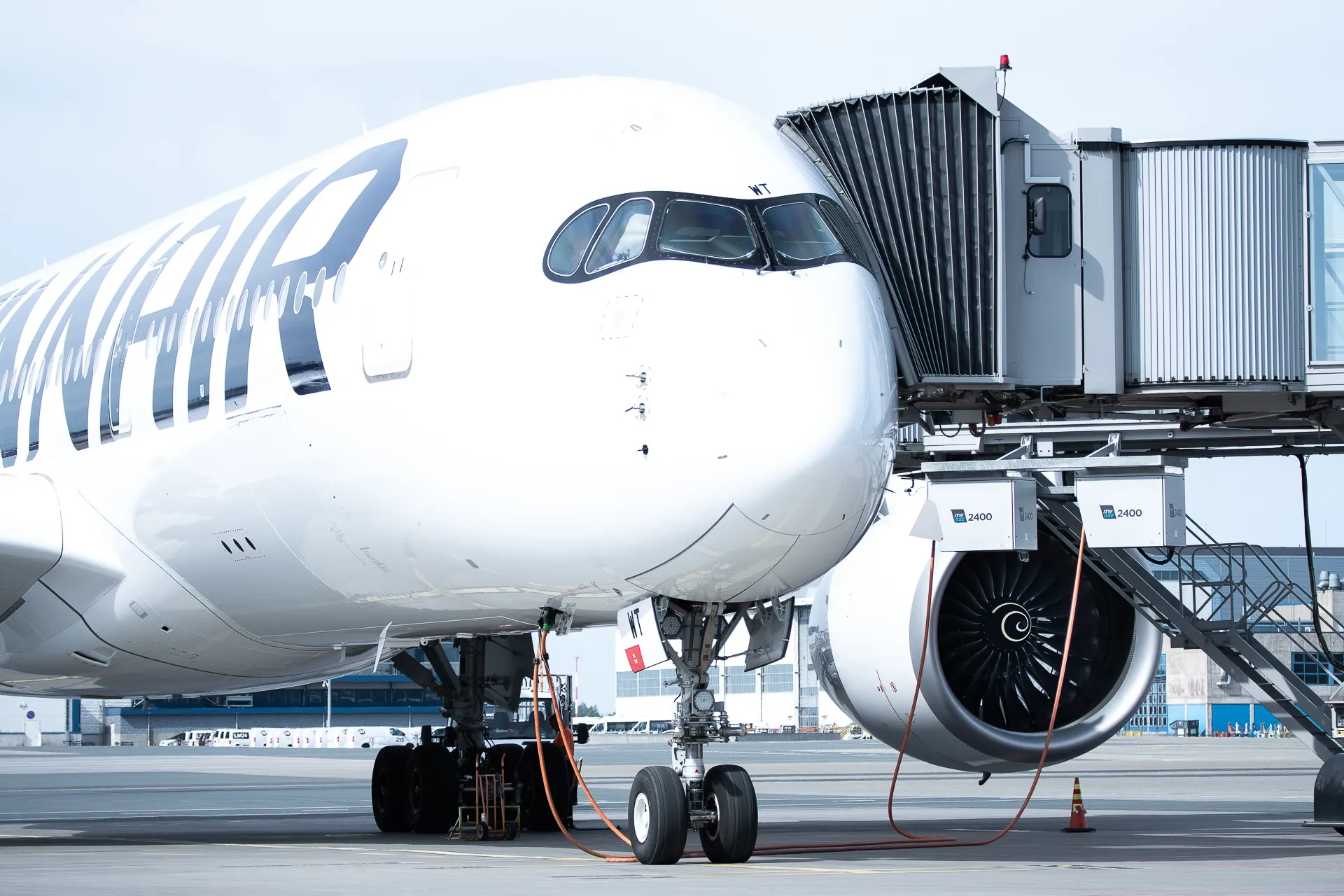HELSINKI — Finnish company Liquid Sun, in cooperation with Finnair (AY), ABB, Fortum, and airport operator Finavia, is launching a unique pilot project to produce renewable, sustainable aviation fuel electro Sustainable Aviation Fuel (eSAF) from biogenic CO2 emissions.
First-of-its-kind eSAF Production
Based on research carried out at Tampere University, Liquid Sun has developed an innovation based on low-temperature electrolytes technology used to convert CO2 emissions and renewable hydrogen into eSAF.
Production is set to launch in Autumn 2025 in Eespo, Finland. The new electro-fuel production unit is the first of its kind and is aiming to establish a functioning ecosystem for synthetic fuel production in Finland.
Cooperation with Finnair, ABB, Fortum, and Finavia will support the development of eSAF production and develop globally scalable processes to secure the future supply of domestically produced SAF in Finland.
“Finland has the opportunity to become a leading producer in the rapidly emerging sustainable aviation fuel market. To achieve this goal, it is critical that the project brings together industrial partners across the eSAF value chain with a shared ambition to accelerate the transition to sustainable fuels,” said Pasi Keinänen, CEO of Liquid Sun.
ReFuelEU Aviation
At the beginning of 2025, the European Commission’s ReFuelEU Aviation mandate entered into force, promoting an increase in renewable fuel usage in aviation through 2050.
In 2030, the mandate will include fully synthetic fuel produced from CO2, such as eSAF. By 2050, the fuel blending requirement will rise to 70%, with half of this requirement being SAF.
Mandate applies to airports with at least 800,000 passengers and 100,000 tonnes of cargo annually. In Finland, Helsinki Airport (HEL) and Rovaniemi Airport (RVN) fall under the mandate.
“As the owner of Finland’s airports, we at Finavia want to do everything we can across the aviation value chain to support more sustainable air travel. This means bold climate collaboration with our stakeholders, and actively understanding and testing new technologies across our airport operations,” says Henri Hansson, SVP, Airport Infrastructure, Sustainability, Safety, Security & Compliance at Finavia.
Finland as a Producer of Renewable Fuels
Finland has a unique opportunity to become an industry-leading producer of renewable aviation fuels with 20 million tons of biogenic CO2 annually from the forest industry and emissions from biogas plants. Diverse sources enable decentralized eSAF production, stronger energy security, and even distribution across Finland.
“There is a technological race underway to deliver cost-efficient and scalable solutions, and Finland’s conditions and capabilities are highly favorable. We believe rapid piloting and validation are the right approach when building an entirely new industry for synthetic fuels. If successful, this project can give Finland a significant competitive advantage,” said Pasi Keinänen, Liquid Sun.
Collaboration for Renewable Energy Usage
Project development is the result of close cooperation of various companies along the aviation value chain in Finland - Liquid Sun, ABB, Finnair, Finavia, and Fortum.
“Aviation is one of the hardest sectors to decarbonize, and its energy transition will require innovation and collaboration across the value chain. We want to contribute to developing Finland’s capability in synthetic aviation fuel production while advancing the industry’s carbon neutrality goals,” said Riku Aho, Vice President Energy Transition, at Finnair.
“Fortum’s target is to help societies reach carbon neutrality and our customers to decarbonise their processes. For aviation fuel production, we are pleased to offer renewable energy and, in the future, hydrogen from the pilot plant we are currently building,” said Satu Sipola, Vice President, Hydrogen and Project Execution at Fortum.
“The goal of ABB Oy’s H2 Springboard program is to promote the development of Finland’s hydrogen economy ecosystem and to accelerate the scaling of hydrogen technology solutions. The Liquid Sun project is an excellent example of broad ecosystem collaboration for developing pioneering solutions,” said Simo Säynevirta, Head of H2 Springboard ecosystem at ABB.
Strong statements from parties of the eSAF pilot project signal Finland’s dedication and proactivity towards meeting goals set by the EU, ensuring a greener future for aviation.
eSAF in Comparison
Producing eSAF from biogenic CO2 emissions is environmentally competitive compared to other SAF production methods, but the details depend on the pathway and feedstock used. Here’s a comparison of key production methods:
1. eSAF from Biogenic CO2
- CO2 Source: Captured from biological processes (e.g., fermentation, biogas plants) where the carbon would be released to the atmosphere if not captured.
- Greenhouse Gas (GHG) Reduction: High. Biogenic CO2 is considered carbon neutral because the original photosynthetic capture offsets emissions from combustion. Life-cycle GHG reduction estimates are typically in the 74–90% range versus fossil jet fuel, depending on efficiency and renewable energy use.
- Land/Resource Use: Lower than crop-based SAF, as it avoids direct land competition if using true waste streams.
2. HEFA (Hydroprocessed Esters & Fatty Acids: Waste Oils, Fats, or Algae)
- CO2 Source: Biogenic, from fats, oils, and waste (e.g., used cooking oil).
- GHG Reduction: Substantial, typically a 74–84% reduction compared to conventional jet fuel. Lower for crop-based (e.g., palm oil) due to potential indirect land use change. True wastes and residues have a better profile.
- Feedstock Concerns: Limited global availability of waste oils; risk of market distortion if crops are incentivized over food or forest.
3. Power-to-Liquid (PtL) or Power-to-X
- CO2 Source: Can be biogenic, fossil (industrial “point source”), or from Direct Air Capture (DAC).
- GHG Reduction: Best when powered solely by renewable electricity and using biogenic CO2 or Direct Air Capture. DAC is the least energy-efficient pathway due to the high energy needed to extract CO2 from ambient air.
- Advantages: Potentially near-zero GHG footprint if green electricity and biogenic or atmospheric CO2 are used. Minimal land footprint—significant for places lacking biomass resources.
- Challenges: Requires vast amounts of clean energy; currently limited by high cost and infrastructure for hydrogen and DAC.
4. Alcohol-to-Jet (ATJ)
- CO2 Source: Fermentation from plant biomass (corn, sugarcane, or cellulosic waste).
- GHG Reduction: Estimated up to 94%, but highly dependent on land use (direct and indirect), fertilizer use, and how the feedstock is grown. If using food crops, the risk of land-use change offsets the benefits.
- Feedstock: Requires dedicated crops or waste streams; high sustainability if using agricultural wastes.
5. Gasification + Fischer-Tropsch (GFT)
- CO2 Source: Biomass, municipal solid waste, forestry residues.
- GHG Reduction: Between 66–94%, depending on how waste would have been managed otherwise (e.g., landfill methane), and whether the process uses renewable energy.
- Resource Requirements: The availability of suitable waste and residues limits the scale, and there are concerns about air and water emissions from combustion-derived syngas.
Key Environmental Takeaways
- Biogenic CO2–based eSAF is among the least environmentally harmful options when using bona fide waste or residue streams and renewable energy. It generally outperforms crop-based HEFA or ATJ pathways in terms of land and water use and avoids many land-use change risks.
- Power-to-liquid (PtL) using renewable power and biogenic or DAC-CO2 can potentially achieve the lowest total GHG emissions—possibly approaching net zero—but at present, DAC is highly energy-intensive and expensive.
- Waste-residue-based SAF (any method) typically offers the best lifecycle GHG and resource profile due to avoided waste management emissions and lack of land use competition.
- Methods using crop-based feedstocks (food crops) can have significant indirect emissions due to land use change and should be minimized as per current sustainability frameworks.
While still a faraway source of propulsion energy, eSAF from biogenic CO2 might become highly competitive environmentally and, when powered by renewable energy and sourced from waste streams, rival or exceed the benefits of most alternative SAF pathways, especially compared to crop-based or fossil-derived feedstocks.




